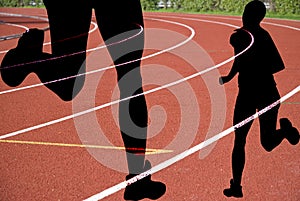
For some people walking into a gym may be done begrudgingly or accompanied by a loathsome sigh; they meander in to see ab array of cardio equipment on one side and the weights on the other and vaguely go about doing something. While this may be a common state of mind for a large group of the populous, (America is still struggling with not only obesity but
sadly an aversion to not only exercise but any kind of exertion in general it seems at times!) that is not the case with everyone nor does it have to be. I honestly love to run, to break a sweat, to feel those muscles working, and yes even embrace that burn of a hard workout; and
I know I'm not alone in that thinking. But even if you don't necessarily cite working out as one of your top five favorite things to do it by no means has to be a chore.
Granted you will to some degree need to move out of that comfort level; this will include some pain but it is the 'good' kind of pain. Sore muscles are both earned and something to be proud of; it means you put in some hard work and while having to gently lower yourself into a chair due to some tender quads may not seem like a reward it is because it means you are making your body stronger, tighter, leaner, and more powerful. I think some people may be afraid to push themselves hard enough to see the results of a fitness program and then when they don't see the results they want they give up; instead I think they need to shift their mindset, go in with a solid idea of what they want to accomplish, and then be realistic in knowing it will take hard work and yes...perspiration.
All too often we've seen the overweight person slowly pedaling the stationary bike at 10 RPM's, barely moving; they stay on for awhile, do a few half-hearted bicep curls, then hit the showers. You'll notice they always look the same after months and month; they are usually also the same people who complain that they workout every day and aren't able to lose any weight. What they need to do is get a swift kick in the tush to step out of their comfort zone and work harder...of course you can't motivate someone who just doesn't want to do something but here are a few tips for anyone struggling with a lack of
fitness motivation, aren't really sure what they should be doing, or are struggling to get back on the workout wagon.
* Go in with a plan. Just like anything else if you go in without a clue as to what you want to accomplish you'll more than likely have trouble getting much done. Know what your workout will include for the day; that may mean mapping out the week's training schedule in advance. That way when you lace up those sneakers you'll know what you need to do instead of having to make it up on the spot. You'll also be more likely to stick to a planned workout instead of blowing it off, doing it half-hearted, or cutting it short.
* Get a mix of cardio and strength. You want to not only get in a balance of cardio to elevate your heart rate and burn calories but you also want to build muscle mass and strength with weights or resistance work. This can be accomplished by doing at least 30 minutes of running, biking, using the elliptical, jumping rope, or anything that gets you panting. You can follow this up with a weight routing in the gym that targets the major muscle groups; think lunges, curls, lat pull-down, etc. You can even combine both elements in one workout by alternating between bouts of cardio and strength moves. The bottom line is you don't want to neglect one or the other.
* Workout hard enough. If you are doing your cardio but barely breathing hard chances are you aren't getting your heart rate elevated enough. The
goal is to be going hard enough so that you reach your target heart rate zone of about 70-80% of your maximum heart rate; you can find what that is for you as it varies with age and fitness level and then check yourself. Or you can use a scale of 1 to 10 with 1 being what you feel like just laying in bed and 10 being you're running for your life from a wild pack of wolves; you then want to feel like you are exerting yourself at around a level 7.
* Feel the burn. This ties in to the last one but it applies more to strength work; if you are lifting weights but by the last few reps you still feel like you could do 20 more you should increase the weight load. In the weight room you can either go for
higher reps or higher weights depending on what your specific goals are; more reps will lead to a leaner, toned look while less reps and higher weights are going for more bulked muscles. Either way by the end of your sets you want to feel that burn and not like you could keep on going forever.
* Track your progress. It's always encouraging to see that you've improved and that in itself is often motivation enough to keep going and maybe even make you set your goals even higher. That's why
having a training log is beneficial and every now and again you should take a look back at where you were and give yourself some kudos if you are able to lift more, go faster, workout longer, or accomplish anything else...think dropping pounds or fitting into those short shorts you never thought you would.
Working out is fun...all you need to do is find something you actually enjoy and then make the most of it. Hopefully if you are yet to have experienced that endorphin high or are just starting out these tips will set you out on the right track. :)


















 You can build muscle strength with isometric exercises but because you will not be doing any dynamic action often times they are not the first choice of athletes in which they are more concerned with functionable muscle growth. (Exceptions may be doing squats or planks in addition to traditional weights.) Still, these are easily adaptable to retain muscle loss if you have an injury and they will still grant you tone if that's you major concern. Many core exercises are isometric in nature and that is where they are used a great deal. Here are a few isometric exercises that you can integrate into your current routine or do on the go being that with summer comes plenty of vacations. Actually, people that are busy or crunched for time have often used isometrics to 'sneak' in their workouts; you can always contract your abs and hold it for ten to fifteen seconds, relax, and do a few sets while you are typing away at work. You could squeeze those glutes while you are stuck in traffic, and you could hold a squatting position between commercial breaks.
You can build muscle strength with isometric exercises but because you will not be doing any dynamic action often times they are not the first choice of athletes in which they are more concerned with functionable muscle growth. (Exceptions may be doing squats or planks in addition to traditional weights.) Still, these are easily adaptable to retain muscle loss if you have an injury and they will still grant you tone if that's you major concern. Many core exercises are isometric in nature and that is where they are used a great deal. Here are a few isometric exercises that you can integrate into your current routine or do on the go being that with summer comes plenty of vacations. Actually, people that are busy or crunched for time have often used isometrics to 'sneak' in their workouts; you can always contract your abs and hold it for ten to fifteen seconds, relax, and do a few sets while you are typing away at work. You could squeeze those glutes while you are stuck in traffic, and you could hold a squatting position between commercial breaks.